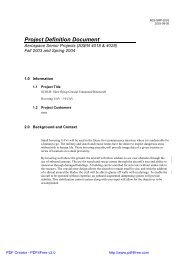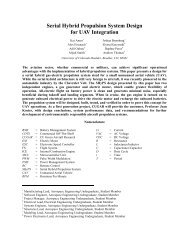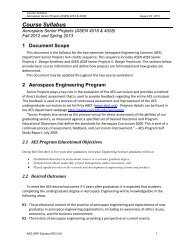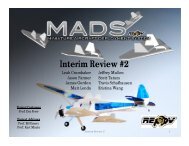PFR - Aerospace Engineering Sciences Senior Design Projects ...
PFR - Aerospace Engineering Sciences Senior Design Projects ...
PFR - Aerospace Engineering Sciences Senior Design Projects ...
You also want an ePaper? Increase the reach of your titles
YUMPU automatically turns print PDFs into web optimized ePapers that Google loves.
Project Final Report – CUDBF April 30 th , 2009<br />
ASEN 4028: <strong>Aerospace</strong> <strong>Senior</strong> <strong>Projects</strong><br />
aircraft. Finally the assembly time was estimated based on the numbers of steps required for<br />
assembly.<br />
The comparison between aircraft configurations began by defining the effects the additional<br />
surfaces have on the aircraft. The lift required by the wing and tail must equal the weight of the<br />
aircraft. The tail lift force from similar sized DBF aircraft is approximately 0.73 pounds 4 . For<br />
the canard, the surface provides positive lift while the conventional tail provides negative lift.<br />
The weight of the aircraft was estimated using 6 pounds for wing and avionics weight, 8 pounds<br />
for payload weight and 0.75 pounds for tail boom construction weight. The wing area was<br />
calculated by the lift required by the wing. Since the canard and conventional both required<br />
bigger wing areas than the flying wing and because the flying wing’s weight was only wing<br />
weight (no tail), it was decided that the canard and conventional aircraft weights needed to be<br />
increased. The weights of these configurations were increased and new wing areas were<br />
computed. This process was iterated until the weights and wing surface areas converged.<br />
Based on a minimum wing span of 5 feet, the aspect ratio was calculated. The aspect ratio is<br />
inversely proportional to the aircraft’s drag. Therefore, the flying wing and canard were both<br />
predicted to have similar drag characteristics while the conventional has the most drag.<br />
The assembly time of the aircraft was determined from the number of motions required to move<br />
the aircraft from the aircraft container to a flight ready condition. Since each aircraft must have a<br />
minimum wing span of 5 feet and the maximum box dimension is 4 feet, the wing cannot be a<br />
single piece. Three options are present: two separate wing halves joined by a spar, two wing<br />
halves folded by a hinge on the centerline, or folding wingtips. The folding wingtip design<br />
presents the best option due to the importance of the structural integrity of the aircraft’s center.<br />
Each configuration must have the folding wing tips, but the canard and conventional also have<br />
the large tail structure. This would also require some sort of attachment or folding mechanism.<br />
Additionally, servo connections to the control surfaces would introduce complexity which would<br />
increase the assembly time. The canard and conventional would therefore have similar assembly<br />
times, while the flying wing would have a lower assembly time due to its absence of a tail.<br />
The initial calculations performed for this design selection showed that the flying wing was the<br />
best suited configuration to optimize the overall competition score as seen in Table 3.<br />
.<br />
28
















